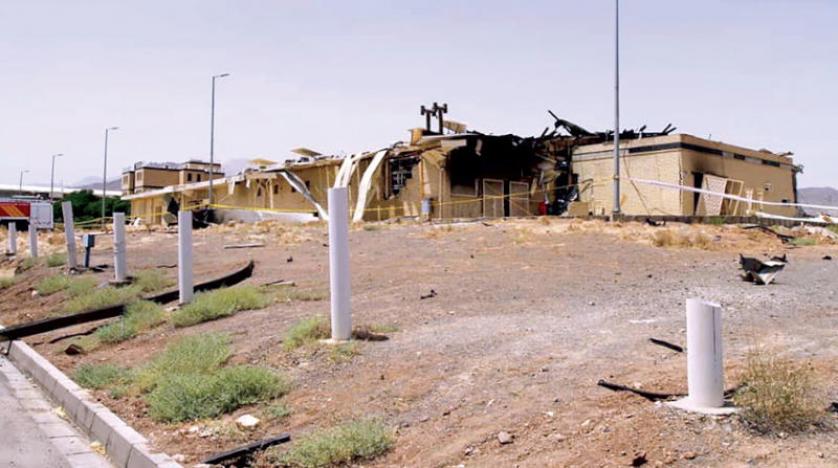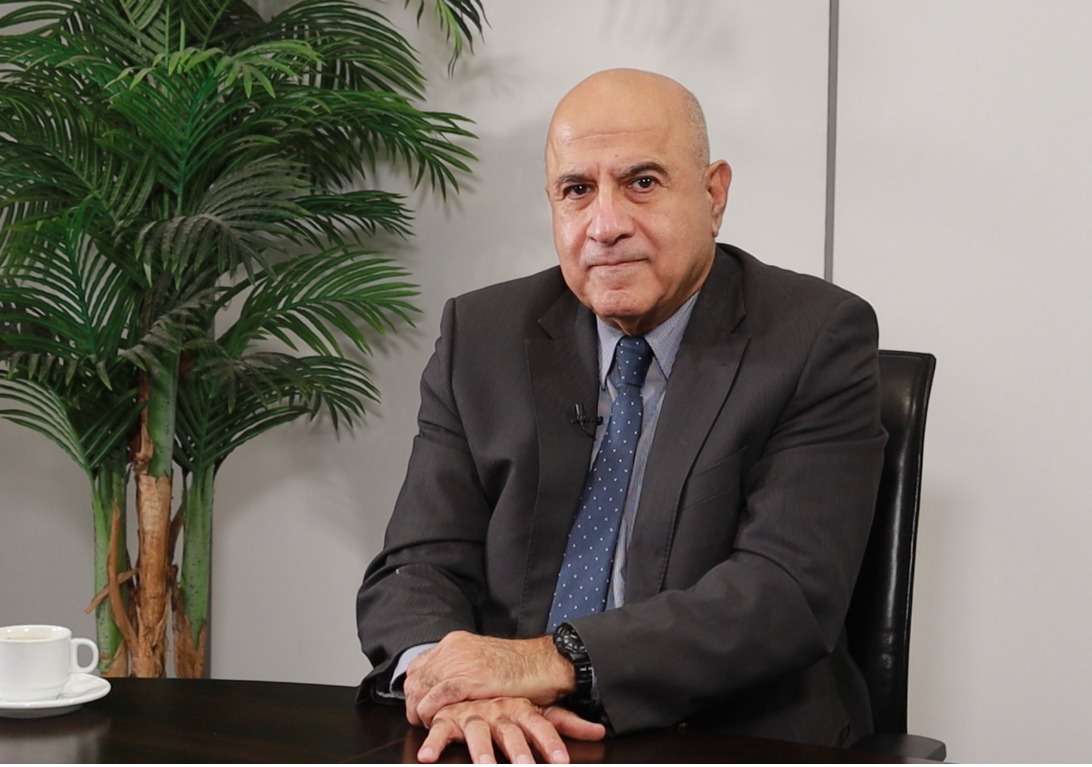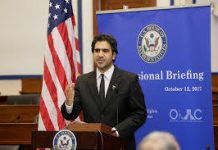حادث «غامض» في منشأة نطنز الإيرانية لتخصيب اليورانيوم/الإعلام الرسمي قال إنه «لم يلحق أضراراً»… ومجموعة غير معروفة وجهت رسائل إلى إعلاميين قبل ساعات من البيان الرسمي
لندن – طهران/الشرق الأوسط/03 تموز/2020
Are three mysterious explosions in Iran linked? – analysis
Seth J.Frantzman/Jerusalem Post/July 03/2020
جيرازلم بوست/هل الإنفجارات الثلاثة التي طاولت مواقع حساسة في إيران هي متصلة ببعضها البعض
Mysterious Explosion and Fire Damage Iranian Nuclear Enrichment Facility
David E. Sanger, William J. Broad, Ronen Bergman and Farnaz Fassihi/The New York Times/July 03/2020
نيويورك تايمز: انفجارات غامضة وحرائق تدمر موقع إيراني للتخصيب النووي
**********************
حادث «غامض» في منشأة نطنز الإيرانية لتخصيب اليورانيوم/الإعلام الرسمي قال إنه «لم يلحق أضراراً»… ومجموعة غير معروفة وجهت رسائل إلى إعلاميين قبل ساعات من البيان الرسمي
لندن – طهران/الشرق الأوسط/03 تموز/2020
أعلنت إيران، أمس، أن حريقا اندلع في منشأة نطنز النووية، دون أن يسفر عن تلوث إشعاعي أو خسائر بشرية، وذلك في ثاني حادث غامض في أقل من أسبوع، بمنشآت تحظى بأهمية استراتيجية بالغة، بعد الانفجار الذي هز موقعا في شرق طهران، كشفت معلومات بأنه مصنع للصواريخ الباليستية.
وفي بداية الأمر، نقلت وكالات رسمية إيرانية عن المتحدث باسم منظمة الطاقة الذرية بهروز كمالوندي قوله إن حادثا وقع في منشأة نطنز، لم يسفر (الحادث) عن خسائر بشرية أو أضرار مادية. ومنشأة نطنز لتخصيب اليورانيوم موقعا استراتيجيا في البرنامج النووي الإيراني، تخضع لتفتيش من جانب الوكالة الدولية للطاقة الذرية التابعة للأمم المتحدة. وكان لافتا منذ اللحظات الأولى إن الحادث في المنشأة الحساسة تسبب في إرباك منظمة الطاقة الذرية الإيرانية، إذ دفع المتحدث باسمها باتجاه التقليل من أهمية الحادث عندما قال «لا داعي للقلق من احتمال حدوث تلوث لأن إحدى الصالات المسقوفة، التي قيد الإنشاء في فناء موقع نطنز هي التي تضررت وليس المنشأة ذاتها» حسب وكالة «أرنا» الرسمية. وتابع كمالوندي أن «فرق الخبراء متواجدة بالموقع راهنا وتحقق بسبب الحادث». وأضاف أن المجمع الواقع في وسط إيران «لا يشهد حاليا نشاطا وهو ما يعني أنه خال من مواد مشعة»، موضحا أنه «لم يكن هناك انقطاع في عمل موقع التخصيب نفسه»، الذي «يعمل بالسرعة التي كان يعمل بها» سابقاً، وفقا لوكالة الصحافة الفرنسية.
وأصدرت منظمة الطاقة الذرية الإيرانية، لاحقا قالت فيه إن المستودع قيد الإنشاء ولم يتسبب الحادث في وقوع إصابات. وفي وقت لاحق، أفادت وكالة «تسنيم» المنبر الإعلامي لجهاز استخبارات «الحرس الثوري» نقلا عن رمضان علي فردوسي حاكم مدينة نطنز بالقرب من أصفهان، أن «الحادث نجم عن حريق»، مضيفا أنه تم إرسال رجال الإطفاء إلى الموقع، دون أن يقدم تفاصيل عن سبب الحريق. وبعد ساعات، قالت الوكالة الدولية للطاقة الذرية إنها على علم بتقارير الحريق. وأفادت في بيان «لا نتوقع حاليا أي تأثير على أنشطة التحقق من الضمانات للوكالة الدولية للطاقة الذرية».
وأظهرت صورة نشرت في وقت لاحق من قبل وكالة الطاقة الذرية مبنى عليه علامات الحرق وعلى سقفه آثار الدمار، ما يشير إلى احتمال وقوع انفجار. أما وكالة «رويترز» فقد نسبت إلى خبراء قولهم إنه «لم يستبعد احتمال حدوث عمل تخريبي نظرا لأهمية موقع نطنز». ونقلت عن مسؤول نووي إيراني سابق «بالوضع في الاعتبار أن هذا الحادث المزعوم قد وقع بعد أيام قليلة من الانفجار قرب قاعدة بارشين العسكرية، فلا يمكن استبعاد احتمال العمل التخريبي». وأضاف «تعرضت منشأة نطنز للتخصيب في السابق لهجوم إلكتروني»، في إشارة إلى هجوم بفيروس ستوكسنت وقع عام 2010 وألحق أضرارا بأجهزة الطرد المركزي، ويعتقد على نطاق واسع أن الولايات المتحدة وإسرائيل تقفان وراءه. ووقع انفجار شرقي طهران، الجمعة الماضية، قرب مجمع عسكري حساس، وقالت السلطات إنه ناجم عن تسرب من صهريج بمنشأة لتخزين الغاز في منطقة عامة.
وتعتقد أجهزة الأمن الغربية أن طهران أجرت تجارب تتعلق بتفجيرات نووية منذ أكثر من عقد في قاعدة بارشين العسكرية، وكان دخول المفتشين الدوليين إليها سبق تأييد الوكالة الدولية للاتفاق النووي قبل إعلان توقيعه.
وكانت صحيفة «نيويورك تايمز» قد أفادت الاثنين، أن صور الأقمار الصناعية أظهرت أن الانفجار وقع في قاعدة بمنطقة «خجير» على بعد 24 كلم، شمال غربي قاعدة بارشين، وهي منشأة مغطاة بأنفاق تحت الأرض، لإنتاج الصواريخ والوقود السائل والصلب المستخدم في الصواريخ، ويشتبه منذ فترة طويلة، أنها موقع رئيسي لترسانة إيران الصواريخ (الباليستية) المتنامية. ومن بين الفرضيات التي أعقبت الانفجار في الموقع الصاروخي، احتمال تعرضها لهجوم إلكتروني إسرائيلي، نظرا لتزامن الانفجار مع قطع شامل للكهرباء بمدينة شيراز، مركز محافظة، فارس، لكن وسائل الإعلام الإيرانية، قللت من أهمية ذلك.
بدورها، أفادت وكالة أسوشييتد برس عن خبراء أنهم يعتقدون أن الحريق بمنشأة نطنز «أصاب منشأة جديدة لإنتاج أجهزة الطرد المركزي».
ويعتقد الخبراء أن الحريق ضرب خط الإنتاج في المنشأة، بناء على صورة نشرتها إيران من موقع الحريق وصور الأقمار الصناعية.
في الأثناء، ذكرت الخدمة الفارسية في هيئة الإذاعة البريطانية «بي بي سي» أن قبل ساعات من نشر أول خبر عن الحادث، فريق من مراسليها تلقوا بيانا من مجموعة تطلق على نفسها «فهود إيران»، أعلنت مسؤوليتها عن القيام بـ«عملية» في منشأة نطنز.
وأفادت «بي بي سي» الفارسية أن «المجموعة سرية تزعم أنها معارضة وحاضرة في الأجهزة الأمنية الإيرانية». وتابعت أن المجموعة ذكرت في البيان إن «منشأة كاشان النووية والأقسام الجديدة بمصنع أجهزة الطرد المركزي أحد أهداف العملية، لأن فضلا عن أهميتها المواقع، أنها غير سرية ولا يمكن إنكار تدميرها».
وأعلنت طهران في مايو (أيار) 2019 تعليق عدد من الالتزامات التي ينص عليها الاتفاق النووي المتعدد الأطراف، والذي انسحبت منه الولايات المتحدة بشكل أحادي في 2018. وأعادت طهران تخصيب اليورانيوم في نطنز في سبتمبر (أيلول) الفائت، بعدما كانت اتفقت مع القوى الدولية على تعليق تخصيب اليورانيوم به بموجب الاتفاق. وفي يوليو (تموز) 2018. أعلن رئيس منظمة الطاقة الذرية الإيرانية علي أكبر صالحي عن بناء إيران مصنعا لإنتاج طرد مركزي متطورة، خاصة طراز «IR – 6» بمنشأة نطنز، في إطار أوامر لـ«المرشد» علي خامنئي بتسريع عملية التخصيب. وكشف حينذاك أن القسم الجديد يتطلب 18 شهرا لدخوله الخدمة. ويأتي الحادث بعد أسابيع قليلة من انتقادات وجهتها الوكالة الدولية للطاقة الذرية، إلى إيران لعدم إتاحتها موقعين، يعتقد أنها شهدت أنشطة «سرية» إيرانية، قبل الاتفاق النووي ولم تبلغ بها الوكالة الدولية. ومنح الاتفاق الموقع في 2015 إيران تخفيفا للعقوبات مقابل قيامها بالحد من برنامجها النووي. وأعقب الرئيس الأميركي دونالد ترمب انسحابه من الاتفاق بإعادة فرض عقوبات مشددة أحادية على طهران، بعدما وصف الاتفاق بـ«المعيوب» ودعا إيران إلى توقيع اتفاق أشمل يتضمن أنشطتها الإقليمية وتقييد تطوير الصواريخ الباليستية.
Are three mysterious explosions in Iran linked? – analysis
Seth J.Frantzman/Jerusalem Post/July 03/2020
جيرازلم بوست/هل الإنفجارات الثلاثة التي طاولت مواقع حساسة في إيران هي متصلة ببعضها البعض
Three mysterious incidents, linked by explosions – at least two of them at secretive nuclear and weapons facilities – have rocked Iran in the past week.
Three mysterious incidents, linked by explosions – at least two of them at secretive nuclear and weapons facilities – have rocked Iran in the past week. All three have been reported by Iranian media with various excuses about how they are less serious than
they appear, that they are being investigated and that there is no major story to tell.
On June 25, a massive explosion, seen many miles away in Tehran, burned a hillside near a missile complex at Khojir. On June 30, a medical center suffered a fire in Tehran, killing at least 18 people. And on July 2, an incident at Iran’s Natanz enrichment facility was mentioned by the country’s official media, without elaboration. Officials claimed that only a shed was damaged. In each case, officials appeared to try to get ahead of the story by obfuscating about the seriousness of the incident or why it took place at a sensitive facility.
This leads to key questions about why so many explosions or incidents have affected key aspects of Iran’s military-industrial complex. Rumors posted on social media and elsewhere online have suggested not only a cover up but also allegations of a “cyber” attack or other concerns about how these incidents unfolded. Iran alleged a cyber attack harmed Shahid Rajaee port in May, in the wake of an Iranian cyber attack on Israel.
AT THE HEART of this are concerns about Iran, increasingly pressured by US sanctions, lashing out across the region. The Islamic Republic has systematically walked away from the 2015 Iran deal, enriching uranium and ramping up its weapons programs. It has focused on ballistic missiles and precision guidance for munitions, as well as drones and nuclear facilities. The Natanz facility was well known for being affected by the malicious Stuxnet computer worm in 2010. Stuxnet was developed by the US and Israel according to The New York Times, and may have destroyed up to 1,000 centrifuges at the Natanz facility.
Natanz consists of a fuel enrichment plant and is Iran’s largest gas centrifuge uranium enrichment facility, according to the BBC. It began working in 2007. Iran’s Behrouz Kamalvandi, spokesman for the Iranian Atomic Energy Organization, said on July 2 that there were no casualties at Natanz and that the incident was being investigated. He said there was no need to worry about the possibility of contamination “due to the inactivity of the complex.” It was a strange statement, to deny that anyone had been injured and highlight that the facility was not operating. Kamalvandi’s statements headlined the Iranian Students News Agency website and others in Iran on Thursday.
At the same time, Tehran prosecutors have said that the explosion at the Sina Medical Center in Tehran was unintentional. But at least 18 people are dead. High level officials in the government speaking about the June 30 explosion also highlighted the mystery of it. If it was just a routine tragic fire and mistake, what was the need to have high-level officials looking into it, commenting on it and vowing to investigate?
The explosion at the medical center may be less mysterious than the Natanz and Khojir incidents because it is not immediately clear what links it to Iran’s clandestine military programs. For instance, the explosion at Khojir was initially said by Iran to be in Parchin, with media showing a gas tank that had exploded. The size of the explosion caught on video seemed much bigger than the gas tank Iran alleged it came from.
KAMALVANDI HAS been Iran’s point man for explaining the country’s willingness to systematically break the Iran deal guidelines. In August 2019, he said that Iran could reach up to 20% enrichment of uranium. He confirmed further breaches of the nuclear deal that July. Iran says this is in response to the US walking away from the deal in 2018. An accident or explosion at Natanz would call into question what Iran is really up to and whether its nuclear facilities are as secure as Iran says they are.
The need to rush Kamalvandi in front of the cameras to get Tehran’s story out first appeared to underline his agenda. This also appears to be the messaging behind the medical center and Khojir explosions: Get the news our first so rumors don’t spread. That is why Iran admitted that people died at the medical center and tried to show video of what they claimed was the minor Khojir explosion. This sounds a bit like “nothing to see here.”
Iran can’t hide the Khojir incident because it was too big. Conspiracy theories have been advanced about what might have occurred. Why are at least two of the incidents linked to “gas canisters”? That was the explanation given for the medical center explosion. When the medical center exploded, many reports noted that it was only four days after the Khojir explosion and that both involved gas leaks – supposedly.
While Iran’s Tasnim and Fars News media, linked to the IRGC, posted photos of the medical center explosion, one article at Iran’s official IRNA website said that the center was not linked to radioactive materials. Iraj Harirchi, Iran’s deputy health minister who is well known for having had COVID-19 in February, said that the Sina Athar D-Clinic was a dental and imaging center and there were no radioactive materials affected. He appeared to deny it was linked to any nuclear issues. This is also a strange statement: a high-level official denying rumors apparently floating online. He appeared to deflect the rumors by claiming there was regular radiology at the center.
IT APPEARS that Iran’s messaging is directed at the international community as well as for internal consumption to allay concerns that something very bad is happening in Iran. Iranians consume media reports and the public has been on edge for a year due to sanctions and protests last year that saw the government kill some 1,500 people and shut down the Internet. Protesters have been angered at Tehran’s insistence at plowing money into weapons programs rather than local social programs. Explosions at Natanz and the missile facility at Khojir will lead to questions among the public.
This leaves us with three mysterious incidents and no clear answer as to how they are linked. The Khojir explosion was shown to be falsely linked to Parchin when in fact it was likely at a ballistic missile site linked to important industrial groups that built Iran’s solid- and liquid-fueled missiles. What we can see on the surface however is just a burned patch of earth. It may be that whatever exploded has deeper roots underground. Some of these sites appear nondescript on the surface – just a warehouse or shed – while they are actually more important than they seem.
What is clear is that Iran has attempted to admit and showcase these incidents rather than hide them. This appears to be a concerted effort to try to pretend that it is hiding nothing, such that US officials or others cannot point to these sites after the event and show the explosions as evidence Iran is up to something nefarious. Asked about the explosion at Khojir, for instance, US-Iran envoy Brian Hook was non-committal on a visit to Israel.
Tehran will be quick to try to move these stories off the front page. Having “admitted” that nothing important happened, it will then go on to highlight other regional issues, such as the Houthis fighting Saudi Arabia or Hamas “resisting” Israel. Any suggestion that three incidents in Iran in a week are linked can be brushed aside by Tehran by saying they had already been investigated and commented upon.
Mysterious Explosion and Fire Damage Iranian Nuclear Enrichment Facility
David E. Sanger, William J. Broad, Ronen Bergman and Farnaz Fassihi/The New York Times/July 03/2020
نيويورك تايمز: انفجارات غامضة وحرائق تدمر موقع إيراني للتخصيب النووي
Iran released a photograph showing evidence of what appeared to be a major explosion at the site. Early evidence suggests it was most likely an act of sabotage.
A fire ripped through a building at Iran’s main nuclear-fuel production site early Thursday, causing extensive damage to what appeared to be a factory where the country has boasted of producing a new generation of centrifuges. The United States has repeatedly warned that such machinery could speed Tehran’s path to building nuclear weapons.
The Atomic Energy Agency of Iran acknowledged an “incident” at the desert site, but did not term it sabotage. It released a photograph showing what seemed to be destruction from a major explosion that ripped doors from their hinges and caused the roof to collapse. Parts of the building, which was recently inaugurated, were blackened by fire.
But it was not clear how much damage was done underground, where video released by the Iranian government last year suggested most of the assembly work is conducted on next-generation centrifuges — the machines that purify uranium.
A Middle Eastern intelligence official, who spoke on the condition of anonymity to discuss closely held information, said the blast was caused by an explosive device planted inside the facility. The explosion, he said, destroyed much of the aboveground parts of the facility where new centrifuges — delicate devices that spin at supersonic speeds — are balanced before they are put into operation.
The fire and explosion took place inside the nuclear complex at Natanz, where the Iranian desert gives way to barbed wire, antiaircraft guns and an industrial maze. The damaged building is adjacent to the underground fuel production facilities where, a decade ago, the United States and Israel conducted the most sophisticated cyberattack in modern history, code-named “Olympic Games.” That attack, which lasted for several years, altered the computer code of Iran’s industrial equipment and destroyed about 1,000 centrifuges, setting back Iran’s nuclear program for a year or more.
The early evidence strongly suggested on Thursday the damage was in fact sabotage, though the possibility remained that it was the result of an industrial accident.
The timing was suspicious: A series of unexplained fires have broken out in recent days at other facilities related to the nuclear program. Still, experts noted that if the explosion was deliberately set, it showed none of the stealth and secrecy surrounding the complex cyberattacks by the United States and Israel that were first ordered by President George W. Bush toward the end of his term, and then extended by President Barack Obama.
The Persian language service of the BBC reported that several members of its staff received an email from a previously unknown group, which referred to itself as the Homeland Cheetahs, before news of the fire became public. The group claimed responsibility and said it was composed of dissidents in Iran’s military and security apparatus. They said the attack would target aboveground sections of the targeted facilities so that the Iranian government could not cover up the damage.
There was no way to confirm if Homeland Cheetahs was a real group, and if so whether it was domestic, as it claimed, or supported by a foreign power.
The facility is a key choke point in Iran’s ambitions to speed up its nuclear work, as part of an effort to pressure the United States to suspend the sanctions President Trump has reimposed, and to convince Europe to compensate it for lost revenues as its oil revenue has dried up.
Secretary of State Mike Pompeo, who previously served as Mr. Trump’s C.I.A. director and ordered new operations to disrupt Iran’s nuclear progress, told the United Nations Security Council on Tuesday that Iran’s advanced centrifuges posed a threat.
“Iran is also accumulating dangerous knowledge,’’ he said, arguing for an extension of an arms embargo on Tehran that expires in October. “Late last year, Iran announced that its scientists were working on a new centrifuge — the IR-9 — that would allow Tehran to enrich uranium up to 50 times faster than the IR-1 centrifuges allowed” under the Obama-era deal.
David Albright, the president of the Institute for Science and International Security, a nonprofit group in Washington that tracks nuclear proliferation, said in an interview that a number of factors suggested the disaster was most likely an act of sabotage.
The existence of the facility was no secret: The Iranians promoted its opening in June 2018, and Mr. Albright’s institute described the plant in a report. The Iranians ran a glossy picture of it in a report last year.
The assembly plant, Mr. Albright said, was unlikely to have stockpiled the kinds of highly combustible materials that could generate a large explosion. The Iranian images of the plant released last year show the assembly of the centrifuges — tall, thin machines that enrich, or concentrate, uranium’s rare component, uranium 235.
Enriched to around 3 percent, the fuel can be used in nuclear reactors; at 90 percent, it can fuel atom bombs. Iran has insisted that its operations are entirely for civilian purposes, but both American intelligence assessments and a trove of documents stolen by Israel from an Iranian warehouse in January 2018 showed evidence of planning work on nuclear weapons.
The assembly facility “wouldn’t be prone to these kinds of accidents,” Mr. Albright said. “They get subcomponents and put them together. You wouldn’t have a lot of flammable liquids. The assembly operations are not dangerous per se. It seems like it could be sabotage. It’s a high-value site for the Iranians. It’s a very important building.”
The building is assembling a new generation of centrifuges meant to redouble the pace of Iran’s production of atomic fuel. The spokesman for Iran’s Atomic Energy Agency, Behrouz Kamalvandi, said there was an “incident” at one of the aboveground facilities at Natanz and denied reports that there were centrifuges inside the facility. He said the building was empty and there were no casualties and no damage to the environment.
The central role of the factory complex and its importance for the advancement of Iran’s nuclear ambitions, Mr. Albright said, added weight to the idea of an intentional strike. “It’s not a crazy place to hit if you wanted to set the program back,” he said.
Mr. Albright cautioned that the apparent presence at the plant of a diesel-fuel generator for the production of electricity might in theory explain the roots of the explosion, and said the sabotage idea should be treated with skepticism until proven true.
The factory is a ripe target. “It is a new and very important site and it was already operational,” said Fabian Hinz, an expert on Iran’s military and security and a researcher at the James Martin Center for Nonproliferation Studies at Middlebury Institute.
The assembly work on the centrifuges was permitted under the 2015 nuclear accord that Mr. Obama reached with Iran, and that Mr. Trump exited two years ago.
Shortly after Mr. Trump pulled the United States out of the deal, the Iranians announced they were speeding forward with assembling centrifuges at Natanz and released photographs of the facility and some of its staff.




















